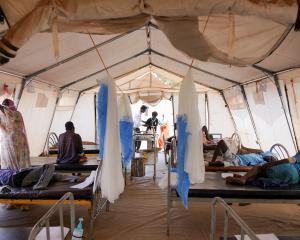It was 42degC in St Louis, Missouri, last weekend, about the same as in Saudi Arabia. Along the United States Atlantic coast, it was cooler, but not much: 41degC in Washington DC, just short of the city's all-time record.
And 46 Americans were already dead from the heat wave.
In Britain, it was incredibly wet.
Almost 6cm of rain fell last Saturday in parts of southern England, and there were more than 20 flood warnings and 100 flood alerts in effect. The wettest April yet was followed by the wettest June (more than double the average rainfall), and July has started the same way.
Russia had its hottest summer yet in 2010, with peat wildfires raging out of control - more than 5000 excess deaths in Moscow in July alone - but this summer it's wet in Russia, too.
Last Friday, an astonishing 28cm of rain fell overnight in the Krasnodar region in southern Russia, and flash floods killed 155 people.
It is a big planet, and some local record for hottest, coldest, wettest or driest is being broken somewhere or other almost every day. But these are records being broken over very large areas, in regions where records go back a long time. As Krasnodar governor Alexander Tkachev said: "No-one can remember such floods in our history. There was nothing of the kind for the last 70 years."
There are very unusual events happening in winter, too: last January only 14.7% of the United States was covered by snow, compared with 61.7% at the same time in 2011. At least 300 people died in a cold wave in northern India in the previous January.
One could go on, enumerating comparably extreme weather events in the southern hemisphere in the past couple of years. But that would just be more impressionistic evidence, and no more convincing statistically. The events are too few, and the time period is too short. But it does feel like something is going on, doesn't it?
The most recent opinion polls indicate that a majority even of Americans now accept that climate change is happening (although, being American, many of them still cling to the belief that it is a purely "natural" event that has nothing to do with human greenhouse gas emissions). But opinion polls are not a good guide in these matters either. Can we really say that something serious is happening, and that it is evidence that the climate is changing NOW?
No, we can't. It's a statistical long shot, but it is possible that this is just a random collection of extreme events signifying nothing in particular.
Occasionally, a tossed coin comes up heads six times in a row. But usually it doesn't.
The best way to approach the question is to ask what we would actually see if global warming had crossed some threshold and triggered big changes in weather patterns. The actual change in the average global temperature would be almost imperceptible: only one or two degrees C, or the difference in an average day's temperature between 9am and 10.30am. What we would notice is that the weather is getting wild.
We never really experience the climate; what we feel is the daily weather that it produces. A climate that is changing will produce unfamiliar weather - and if it is getting warmer, it will be more energetic weather. Wilder weather, if you like.
That means hotter, longer heat waves, and bigger storms that bring torrential rain and killer wind speeds.
But it can also mean prolonged droughts as rainfall patterns change - and much more severe winters, like the "Snowmageddon" storm that hit Washington DC in February 2010 and shut down the US Federal Government for a week.
That last phenomenon confuses people who think colder winters prove that the climate isn't getting warmer, but complex systems like the climate can produce strange local results. As an article by C.H. Greene and B.C.
Monger in a recent issue of Oceanography points out, the melting of the Arctic sea ice will cause colder WINTER weather in the temperate regions of the northern hemisphere.
"Since the dramatic decline of Arctic sea ice during summer 2007," the authors point out, "severe winter weather outbreaks have periodically affected large parts of North America, Europe and East Asia. During the winter of 2011-12, an extended and deadly cold snap descended on central and eastern Europe in mid-January (with temperatures approaching -30degC) ... By mid-February, the death toll had exceeded 550."
How does melting Arctic sea ice cause colder winters?
Much of the solar heat absorbed by the ice-free parts of the Arctic Ocean in the summer is released into the air by evaporation in the autumn. The higher atmospheric pressure in the Arctic weakens the jet stream, which allows cold Arctic air masses with a high moisture content to spill out into the middle latitudes. Hence colder winters and more snow in the US, Europe and northern Asia.
You can't prove that all this means we are sliding into a new and steadily worsening climate right now - that the long-threatened future has arrived.
The statistics aren't good enough to support that conclusion yet. But if you have to put your money down now, bet yes.
• Gwynne Dyer is an independent London journalist.













